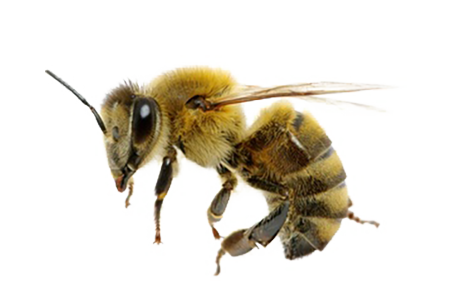Bees

BEES: Africanized (apis mellifera)
Description:
The two most common types of bees in Southern California are the European Honey Bee and its more aggressive hybrid, the Africanized Honey Bee. Both bees look practically identical making it virtually impossible to tell them apart in the field. Both are about one-half inch long, having two pairs of wings with the front pair being larger and longer. The bodies are constricted in the middle and the larger rear portion is banded, typically black/dark brown and yellow. They can be seen collecting nectar from flowers or going to or from an entrance to a cavity in a tree, the ground, or a building. They are also seen moving in a large swarm or collected together in an oval-shaped ball hanging from a tree branch, usually about the size of a football or smaller.
Biology:
As social insects, Honey Bees have a hierarchy of a queen, workers, and drones that form large colonies. The worker bees are the one most commonly seen gathering nectar from flowers. Individual bees are usually quite docile when foraging for food. They carry pollen and nectar back to the hive, which is tended by the rest of the colony to form honey. Honey Bees often start hives in wall voids and attics of buildings and other structures. Africanized Honey Bees build their hives in ground holes, water boxes, woodpiles, air conditioner voids, electrical boxes, vents, or other voids, often in or close to the ground. If their hive is disturbed they attack and sting the intruder in mass. Unlike European Honey Bees which are fairly docile, Africanized Honey Bees, also known as “killer bees”, are very aggressive. They swarm often and have been known to chase a person up to a quarter of a mile. They can be very dangerous to humans and animals and have been known to cause serious injury or even death.
Did You Know?
Bees have a sense of smell that's 50 times more powerful than a dog's, and their antennae have more than 300 taste receptors. They can also sense the hormone humans release when they're scared and will attack if they feel their hive is threatened.
Impact:
Left unchecked, Africanized Honey bees are then a nuisance, they are a serious liability. Because of the threat they present it is crucial to remove them. However, any type of honey bee can cause damage. The longer a hive is active in a wall void, attic, or other space the more honeycomb will build up. After the bees are removed the honey and honeycomb should ALWAYS be removed and cleaned up. Leaving the honey and honeycomb will lead to the honey spoiling and dripping into the building causing untold damage to the structure inside and out.
Solutions:
A licensed professional should always be contacted to remove Honey Bees. At Pestgon, our technicians are specially trained and licensed to remove all Honey Bees and to help you with the complex process of bee hive removal and subsequent repair.
Additional Links:
http://www.ipm.ucdavis.edu/PMG/PESTNOTES/pn74159.html
